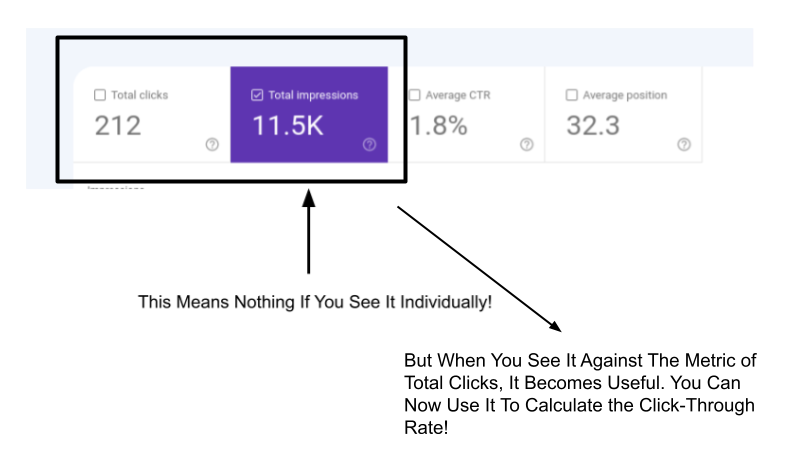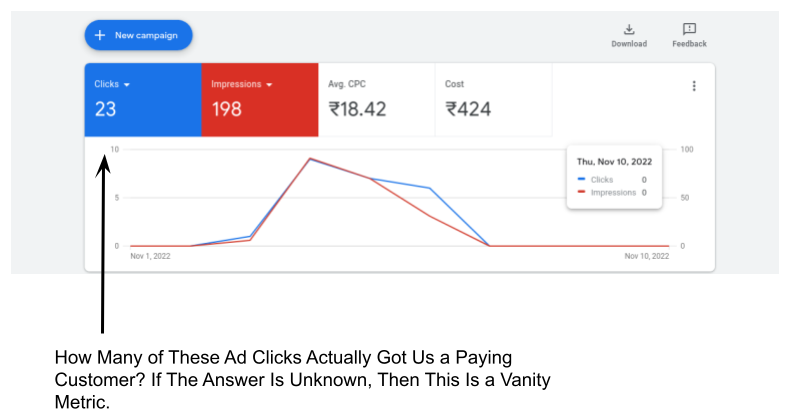We all have heard that proverb – “All that glitters is not gold.” This is exactly the case with vanity metrics. With vanity metrics, you can show huge numbers and impressive KPI based performance. But from a business point of view – or to be more blunt – in terms of earning money, vanity metrics have no information to show. They don’t show insights that are actually helpful to your business and profitability. In this article, we will talk about which KPI is most likely to be a vanity metric, what exactly is the definition of such metrics, and why they aren’t useful.

What Are Vanity Metrics?
As the name suggests, vanity metrics are those metrics that help you show off – in front of your boss or your client. These metrics look good in the chart with inflated numbers and high bars – more green, less red. But these metrics don’t reveal the actual business performance, the actual profitability or growth of the business.
In other words, you can fool the world with vanity metrics and even console yourself with these fake numbers, while the harsh reality remains hidden beneath ‘Actual Metrics.’
There are three primary reasons because of which vanity metrics are useless:
- These metrics don’t delve deeper into the business performance. As such, they rarely provide any context to the numbers shown. You can’t gauge the cause or effect of these metrics.
- Secondly, these metrics are misleading. They can make the boss or the client happy for some time. Once they see that despite such inflated numbers, the profit or the conversion rate hasn’t improved much, that’s when everyone gets wrinkles in their forehead.
- Lastly, these metrics are of no use. You can’t leverage these metrics to come to a useful conclusion, improve your marketing strategy or perhaps to increase profitability.
Which KPI Is Most Likely To Be a Vanity Metric? Some Examples
Since we are from the content marketing world, let’s give you some examples of vanity metrics from our domain.
Example 1:
Impressive Impressions
As content marketers, one of our daily tasks is to write and publish content. And there are many metrics to measure the success of those content pieces. Some metrics are vanity metrics, while some metrics are useful. Again some actionable metrics become vanity metrics when certain conditions don’t get fulfilled.
One of the metrics to measure the performance of a web page on Google is Impressions. It shows how many people have seen the title of the web page of our website on Google search results page. The problem is, this metric means nothing. It does not inform us how many people have actually clicked on the title to read our content. There can be millions of people who might see the title of our content on Google search results page. But what good will that do for us? None!

Note: This same vanity metric becomes an actionable metric when we add context.
For example, the metric of Tota Impressions (marked in blue in the image above) is useless if it stands alone. However when you see the same metric against the total number of clicks that the web page received, the Total Impression metric becomes useful. How? Because now, if you want to calculate the click through rate (percentage of people who clicked on the title after seeing it on Google), you need the metric of Impressions.
So remember, a vanity metric can be transformed into a useful metric if we add context.

Example 2
Number of Ad Clicks With No Conversion Data
In the last example we defined Impressions to be a KPI that’s a vanity metric. And we said that clicks are the actual metric that should be treated as an actionable metric. But… When it comes to ads, even the metric of clicks is most likely a vanity metric. Why? Isn’t it useful? Well actually no! Since you are paying for the clicks, you need to measure which clicks actually resulted in conversion. In other words, you need to know which clicks converted into a paying customer. Without the conversion data, the metric of ad clicks is useless.

When it comes to ads, there is a specific metric called ROAS – Return on ad spend. You can’t calculate ROAS unless you know how many people actually converted to customers after seeing your ad.
Example 3
Net Income That Does Not Show Income From Other Sources
Let’s come out of the content marketing world for a while. I am a stock market enthusiast and you will often see me analysing the income reports published by businesses.
Now suppose you see a graph like this

What’s the first thought that comes to your mind? “Wow! The company has turned profitable again!”
What if I tell you that this is a vanity metric.
In 2022, this imaginary company sold 40% of its warehouse and other physical property. Suppose 70% of its income came from “Other Sources”. Is this metric showing the full picture then?
Hence, a metric that shows total income without breaking up to show core business income and income from other sources is misleading and thus a vanity metric. It looks good on the chart. It is not useful to the investors.
Identifying Vanity Metrics
So how to identify which KPI is most likely to be a vanity metric? Here are some tips.
Is The Metric Useful? Is It Actionable?
Look carefully. Is the metric useful? Can you use the metric to correct the course of your business, to tweak your strategies in order to achieve more growth and profit? If the answer is no, then that metric is most probably a vanity one. Not a single vanity metric can be used individually to get something advantageous out of it.
Does It Have Anything To Do With Sales?
This is from the perspective of businesses. Everything in business is seen against the metric of sales. If a certain KPI has nothing to do with sales, then it is a vanity metric. It doesn’t matter how many cold calls an insurance company makes. What matters is how many cold calls end with leads graduating to the next step of the funnel.
Can You In Any Way Use The Metric To Mislead People?
Any metric that can be used to mislead people is a vanity metric. A company that has millions of followers on social media but is unable to convert them – can only display the follower count as a vanity metric. Its social media managers can mislead the CEO and CFO by showing this growth in followers which does not do any actual good!
The Gray Area
Vanity metrics are bad. But you can’t reject them outright. Consider this example. Earlier we said that impressions on Google are useless. Now suppose a company suddenly sees that the Impression of its web pages on Google has suddenly decreased. This vanity metric now becomes a signal that there is something wrong with its SEO strategy, or perhaps Google has launched a new algorithm. A disruption in vanity metrics shows that something is wrong which helps us to be proactive.
Again, one man’s vanity metric can be another man’s actual metric. For example, getting lots of clicks on a company website with zero conversion might be of no use for a company. But for an entity that displays ads on the web pages, getting lots of clicks can translate into ad revenue. So for the second entity, clicks without conversion is not a vanity metric!
Contact Us If You Want To See Real Metrics On Your Content Marketing Activities!





